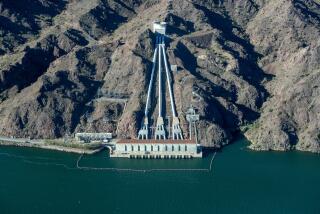Op-Ed: Four dams in the West are coming down — a victory wrapped in a defeat for smart water policy

When a top Interior Department official acknowledged recently that the Trump administration wouldn’t try to block removal of four hydroelectric dams on the Klamath River, he signaled a monumental victory for local Native American tribes, salmon fishermen and the national dam removal movement.
Yet this development is less momentous than it would have been in 2015, when dam removal was just one component of a broad plan for the Klamath Basin, which straddles the California-Oregon border. That plan included salmon habitat restoration, the return of tribal land and water-sharing among farmers, ranchers and tribes. It was the product of a decade of trust-building and honest negotiation among representatives of the basin’s constituencies, whose efforts turned one of the nation’s most contentious water basins into a model of collaboration. It helped that big money didn’t skew the process: Most of the basin’s residents are far from wealthy, and the only corporation involved is PacifiCorp, the utility that owns the dams.
But congressional Republicans declined to support the deal (it required legislative authorization and funding) on the grounds that taking down four obsolete, inefficient and soon-to-be money-losing dams could set a precedent that would eventually threaten, say, Hoover Dam. By espousing an outdated tenet of conservative ideology — all dams are engines of economic development — they sabotaged the interests of their own supporters.
Two years later, the dams are going to come down, but no water-sharing plan will accompany their removal. As a result, the ranchers and farmers in the Upper Klamath Basin, where Republican voters predominate, will not have a reliable source of irrigation water. Upper Klamath farm country is already studded with “for sale” signs. Becky Hyde, an Oregon rancher who courageously fought for a comprehensive basin agreement for many years, says the 2015 plan’s collapse “feels like a betrayal.” She diplomatically declines to say who she thinks the betrayers are.
Given the president’s environmental record, the decision to take down the Klamath dams was made despite its benefits to the river, not because of them.
The good news is that dam removal is virtually certain. Beginning in late September, Alan Mikkelsen, the U.S. Bureau of Reclamation’s acting commissioner, has repeatedly stated that the Interior Department won’t interfere with the application before the Federal Energy Regulatory Commission to dismantle the Klamath’s four dams. FERC approval, widely expected in mid-2019, is the only remaining obstacle to freeing the river.
If the dams come down as planned in early 2020, the event will mark by most measures the nation’s — and perhaps the world’s — biggest dam removal project. The dams’ absence will reopen about 500 miles of river and tributary habitat for salmon, whose numbers have plummeted since the dams were built beginning a century ago. It will end the poisoning of the Klamath River proper, where blue-green algae is now so pervasive that signs warn visitors not to even touch the water for much of its 254-mile length.
Given the president’s environmental record, the decision to take down the dams was made despite its benefits to the river, not because of them. What appeals to Interior Department officials is that removal is the preference of PacifiCorp. The dams’ owner faces the straightforward choice of spending $200 million to take the dams down or spending an unknown multiple of that amount on fish ladders and water quality improvements to secure the dams’ re-licensing, all to continue generating an inconsequential amount of electricity. To the Trump administration, it’s just a business decision, outside the appropriate purview of government. That puts the last remaining opponents of dam removal, the outspokenly conservative Siskiyou County Board of Supervisors in California, in the awkward position of appealing to federal officials to nullify a private corporation’s decision, which stands right-wing dogma on its head.
Some basin farmers and ranchers hold out hope for another round of negotiations and a new water-sharing plan, but developments since the collapse of the 2015 deal have decreased that prospect. For one thing, the senior water right of southern Oregon’s Klamath Tribes was recently judicially affirmed, giving them much less incentive to negotiate. Instead of guaranteeing a minimum share of the basin’s water to the irrigators in dry years, as the tribes agreed to in the 2015 deal, they have cut off flows to the farms and ranches every year since 2013 so they can provide increased protection to the river’s deeply threatened fish populations.
The collapse of the 2015 deal also soured the Klamath Tribes’ governing council on negotiations. “Our congressional folks told us that if we could come up with an agreement that works for all, that it would move through Congress,” Don Gentry, the Klamath Tribes’ chairman, told me over the phone. “We expended a lot of time, developed relationships and reached a solution, and Congress didn’t move it forward. So the question is, what opportunity is really there? Our members have been very frustrated.”
The dams’ dismantling will hearten environmentalists, but the collapse of the grass-roots Klamath Basin plan should hearten no one. Congress undermined an agreement that balanced conservation and agriculture, fish and farmers — a model the West will need in the future. As our water resources dwindle, the Republicans’ reputation for nihilism grows.
Jacques Leslie is a contributing writer to Opinion.
Follow the Opinion section on Twitter @latimesopinionand Facebook
More to Read
A cure for the common opinion
Get thought-provoking perspectives with our weekly newsletter.
You may occasionally receive promotional content from the Los Angeles Times.






